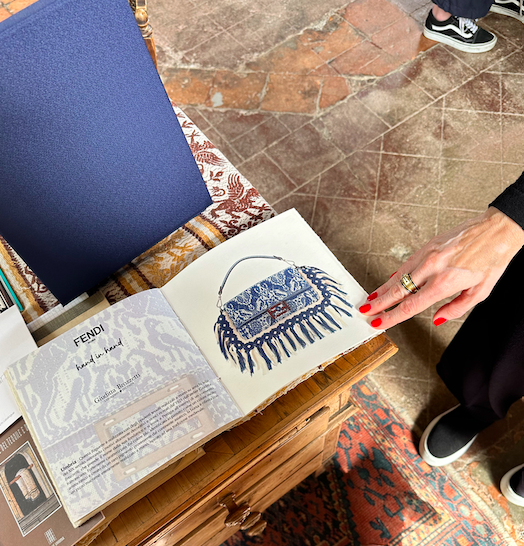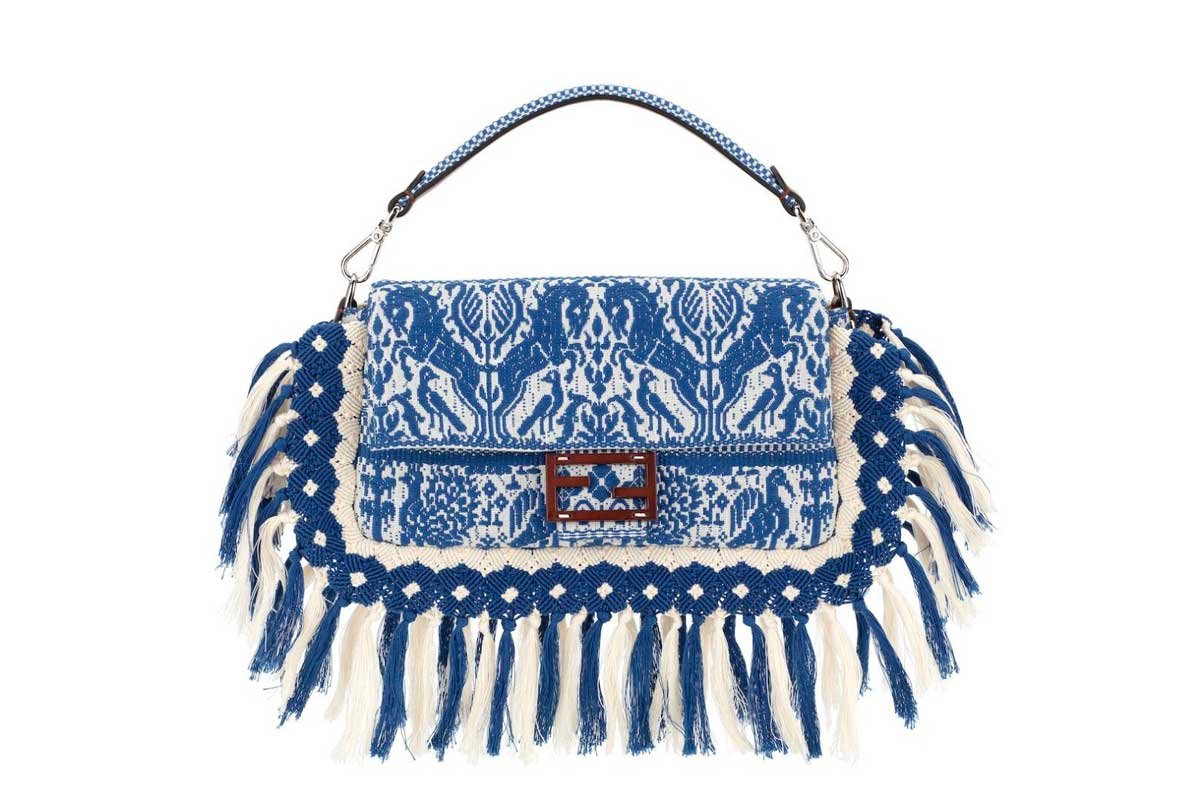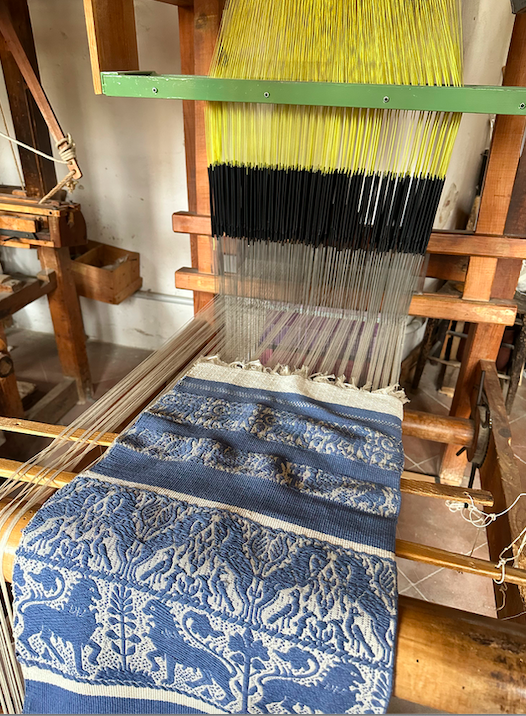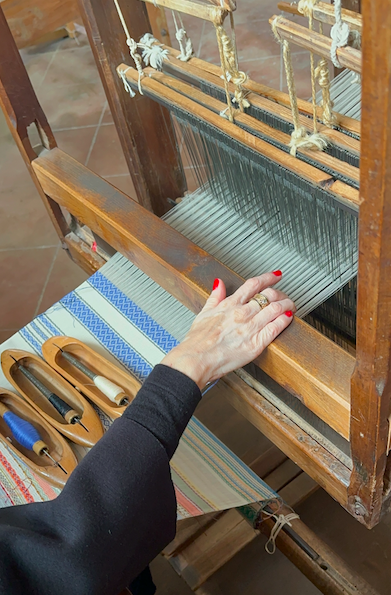Women Doing Cool Shit in Italy: Marta Cucchia
We’ve always been obsessed with connecting our travelers to Italian women doing remarkable things and it’s time to meet Marta, a cornerstone of Umbria’s artistic and historical community. A master weaver and female entrepreneur, Marta is running Italy’s only remaining weaving atelier that both protects and revives the important Umbrian handicraft. (How important is this tradition? Marta is currently recreating the tablecloth from Da Vinci’s ‘Last Supper’ before it is lost to time!) She’s the fourth generation woman in her family that is stewarding this special place which is not just steeped in artistic tradition, but a hundred year old beacon of feminism in Perugia.
A History of Textiles
Stellavision Founder, Zoe, first discovered Marta and her work when Fendi announced their ‘hand to hand’ project which celebrated the anniversary of their baguette bag by tapping an artist in each province to create their version of the famous Italian handbag. While obviously still relevant today, the legacy of Umbrian weaving is even more spectacular. That the craft continues to exist is testimony to the torch-bearing of women. In the Middle Ages, Umbria was a major center for textiles, with Perugian tablecloths and designs in demand all across Europe (such as in the aforementioned tablecloth of Da Vinci's painting of the Last Supper). However, by the 20th century, with changing tastes and industrialization, the craft had become almost forgotten.
Enter Giuditta Brozzetti, who was a director of elementary schools during the First World War. While touring the small schools of the Umbrian countryside, she became intrigued by a noise emanating from local cottages. Upon entering their homes, she discovered the medieval tradition of hand weaving still in play. Passed down from mother to daughter for centuries, the glory days of the high art tradition were past, but local villagers near Perugia were still employing these methods to create practical household textiles.
This experience inspired Brozzetti and in the early 1920s, she dedicated herself to resurrecting the art form. In doing so became an important figure of female entrepreneurship. She bought a few old looms and opened a workshop and school, all while delving into books and paintings to rediscover celebrated designs and techniques. Soon the women of Umbria were producing famous textiles much like they had done centuries before.
This was important not only for the craft but also for the women themselves. Before the workshop, a rural woman's only means to trade was by barter system. Thanks to Brozzetti, they not only had salaried employment, they were now able to manage their finances independently of their fathers and husbands.
Today, the workshop is sadly the only one in existence but thanks to the legacy of Cucchia's great-grandmother, grandmother, mother and now her, this important tradition continues today.
The Church
When you visit the atelier, you will be greeted by the impressive remains of a 12th century church, dedicated appropriately to St. Francis of the Women. It is one of the oldest churches in Italy and it is famous as being one of the few churches to St. Francis that was built during his lifetime. Initially for Franciscan monks, it was eventually given to Benedictine nuns, who being wealthier, were able to fund the addition of the bell tower. Fast forward a few centuries, and after being abandoned several times, the convent was finally closed by Napoleon.
When Cucchia took over the running of the workshop from her mother in 1993, the church was an empty space, unwanted even when her father bought the surrounding property (she recalls playing tennis in the church as a child!) However, after converting the business to a cooperative, she realised the dream of her mother (Clara) and relocated it to the impressive church.
Image courtesy of Atelier Brozzetti
The Looms
While the museum collection has looms from the 17th to the 19th centuries, those currently in general use are called Jacquard looms. The Jacquard machine was invented in France in 1801 and connects with the loom so that the pattern can be created using a series of punch cards. Fascinatingly, this technique had an impact on the early designers of computers, which up to the mid-1970s stored their programs in the same way. People - we’re talking about the very first IBMs!!! If you take a tour of the museum, you will be able to see for yourself practical demonstrations of the looms. Or for the super keen (brava!) Stellavision can help arrange for you to attend a weaving class, where you will be able to create a traditional damask using the Jacquard looms.
One loom of special note is from the 17th century, which after painstaking research, was restored and allowed for the resurrection of a textile from the 16th century, known as the *Fiamma di Perugia *or Flame of Perugia. Lost several times over the years, this type of weaving now survives thanks to the Museum.
Marta’s Weaving
Though she refers to it as her "very expensive hobby," Cucchia is clearly a natural on the loom. She says that weaving is in her DNA, an ancestral memory: "it just comes out." She also credits her neurodivergence as a superpower, allowing her to excel on this particular technique. We were amazed to see her at it. Like a musician playing by ear, she knows instinctively when and which pedals of the loom to push to generate her designs, a talent she credits to her dyslexia. With each pattern she creates, she adds her own modern twist to the rich stories found in the designs of Umbrian textiles.
It was hard not to be inspired by the passion of Cucchia, the feminism of her great-grandmother Giuditta and the legacy of her ancestors. Thanks to the dedication of these Umbrian women, this important cultural heritage has been saved and preserved for future generations.
And after our visit, we couldn’t resist a few more questions for Marta:
How do you feel about running a female-centric business in Italy? What are some of the good things or the challenges?
Condurre un’attività al femminile per me non ha nulla di speciale poiché l’ho visto fare da mia madre e da mia nonna, che sono state precedute da mia bisnonna: nella mia famiglia questa è la normalità ;-) L’unica complicanza è che il nostro lavoro era svolto dagli uomini nell’800 in quanto molto faticoso, ma cerchiamo di aiutarci a vicenda.
Running a female-centric business is not that special to me since I’ve seen it done from my mother and my grandmother, who were preceded by my great-grandmother: in my family this is normality ;-) The only complication is that our work used to be carried out by men in the XIX° century, as it is very tiring, but we try to help each other out.
What is one of your proudest accomplishments with Atelier Giuditta Brozzetti?
Il fatto di esser riuscita a mantenere aperta un’attività anacronistica in un mondo sempre più frenetico.
The fact that I managed to maintain open an anachronistic activity in a world that is more and more frenetic!
How has running the Atelier surprised you?
L’affetto e la partecipazione di tutte le persone che ci vengono a trovare e che ci vogliono supportare, che ci scrivono, che tornano appositamente per noi.
The affection and the participation of all the people who come to see us and who want to support our Atelier, who write to us regularly and come back to Perugia specially for us.
A Travel Tip from Marta:
L’Umbria è una regione meravigliosa ed è ancora poco conosciuta. Il mio luogo del cuore è la piana di Castelluccio dove amo andare per rigenerarmi. La nostra cucina tipica è ricca e varia ma non per vegetariani! Fortunatamente, essendo ancora poco conosciuta, i ristoranti, gli alberghi, le strutture ricettive sono ancora autentiche e c’è poco rischio di sbagliare.
Umbria is a little-known marvellous region. My place of heart is “la piana di Castelluccio” where I love to go to regenerate. Our typical cuisine is rich and varied but not for vegetarians! Fortunately, as it is still little known, most of the accommodation facilities and restaurants are still authentic and there’s little risk to make a mistake.
Visit the Atelier or Shop from Abroad
Shop traditional handmade Umbrian textiles here.
Get more Umbrian travel tips on our friends at EXAU Olive Oil’s blog, where Founder Zoe recommended Three Charming Towns in Umbria to visit.
Have Stellavision plan your bespoke Umbria itinerary by contacting us here.







